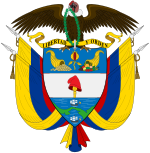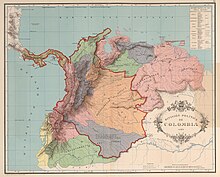Separation of Panama from Colombia
| History of Colombia | ||||||||||||||||||||
|---|---|---|---|---|---|---|---|---|---|---|---|---|---|---|---|---|---|---|---|---|
 | ||||||||||||||||||||
| Timeline | ||||||||||||||||||||
|
||||||||||||||||||||
|
| ||||||||||||||||||||

The Separation of Panama from Colombia was formalized on 3 November 1903 with the establishment of the Republic of Panama from the Republic of Colombia's Department of Panama.
Prelude
After its independence from Spain on November 28, 1821 Panama became a part of the Republic of Gran Colombia which was then also composed by present countries of Colombia, Venezuela and Ecuador.
The political struggle between federalists and centralists that followed independence from Spain resulted in a changing administrative and jurisdictional status for Panama. Under centralism Panama was established as the Department of the Isthmus and during the federalism as Sovereign State of Panama. Panama tried to gain separation during the federalist era, almost achieving it on a few different occasions; 1831; between 1840 and 1841 when a brief state was created and finally during the Thousand Days War (1899–1902), one of the many armed struggles between the Liberal and Conservative Parties, which devastated Colombia and Panama during the nineteenth century. This last civil war ended with the signature of the "Treaty of Wisconsin". However, the Liberal leader Victoriano Lorenzo refused to accept the terms of the agreement and was executed on May 15, 1903.
On July 25, 1903 the headquarters of the Panamanian newspaper "El Lápiz" were assaulted by orders of the military commander for Panama General José Vásquez Cobo brother of the then Colombian Ministry of War as a retaliation for the publication of a detailed article narrating the execution and protests in Panama. This event affected the trustiness of Panamanian liberals on the Conservative government based in Bogotá who later joined the separatist movement.
In 1903 the United States and Colombia signed the Hay-Herran Treaty to finalize the construction of the Panama Canal but the process was not achieved because the Colombian congress did not pass the measure on August 12, 1903. The United States then moved to support the separatist movement in Panama to gain control over the remnants of the French attempt at building a canal.[1]
Separation
Panamanian politician José Domingo De Obaldía was selected to become the Governor of the Isthmus of Panama office that he had previously held and was supported by the separatist movements. Another Panamanian politician named José Agustín Arango began to plan the revolution and separation. The separatists wanted to negotiate the construction of the Panama canal directly with the United States due to the negativity of the Colombian government.
The separatist network was formed by Arango, Dr. Manuel Amador Guerrero, General Nicanor de Obarrio, Ricardo Arias, Federico Boyd, Carlos Constantino Arosemena, Tomás Arias, Manuel Espinosa Batista and others. Manuel Amador Guerrero was in charge of traveling to the United States to get support for the separatist plan; he also gained the support of important Panamanian liberal leaders and the support of another military commander, Esteban Huertas.
With a strong support the separatist movement set November 1903 as the time for the separation. However, rumors in Colombia spread but the information managed by the government of Colombia indicated that Nicaragua was planning to invade a region of northern Panama known as the Calovébora. The Government deployed troops from the Tiradores Battalion from Barranquilla, and instructed the commander to take over the functions of the Governor of Panama José Domingo de Obaldía and General Esteban Huertas, who were not trusted by the government.
The Tiradores Battalion was led by Generals Juan Tovar and Ramón Amaya and arrived to the Panamanian city of Colón in the morning of November 3, 1903. The battalion suffered delays in its way to Panama City caused by the complicity of the Panama Railway authorities who sympathized with the separatist movement. Upon the arrival to Panama City troops were put under the command of Col. Eliseo Torres. General Esteban Huertas commander of the Colombia Battalion in Panama ordered the arrest of Tovar and his other officials.
The Colombian gunboat Bogotá fired shells upon Panama City the night of November 3 causing injuries and mortally wounding Mr. Wong Kong Yee of Hong Sang, China.[2]
An American vessel, the USS Nashville, commanded by John Hubbard, who had also helped to delay the disembarkation of the Colombian troops in Colón, continued to interfere with their mission by alleging that the "neutrality" of the railway had to be respected.
With the huge suppression of the troops the Revolutionary Junta proceeded to declare the separation of the Isthmus and later the independence with the declaration of the Republic of Panama. A naval squadron in the Bay of Panama was captured without resistance. Demetrio H. Brid the president of the Municipal Council of Panama became the de facto President of Panama appointing on November 4, 1903 a Provisional Government Junta that governed the country until February 1904 when the Constituent National Convention was established and elected Manuel Amador Guerrero as first constitutional president. News of the separation of Panama from Colombia arrived to Bogotá on November 6, 1903 due to a problem with the submarine cables.
Reactions
On November 13, 1903 the United States formally recognized the Republic of Panama (after recognizing it unofficially on November 6 and 7). France did the same on November 14, 1903 followed by other 15 countries. On November 18, 1903 the United States Secretary of State John Hay and Philippe-Jean Bunau-Varilla signed the Hay-Bunau Varilla Treaty. No Panamanians signed the treaty although Bunau-Varilla was present as the diplomatic representative of Panama (a role he had purchased through financial assistance to the rebels), despite the fact he had not lived in Panama for seventeen years before the incident, and he never returned.[3] The treaty was later approved by the Panamanian government and the Senate of the United States.
The ambassador of Colombia in Ecuador Emiliano Isaza was informed of the situation in Panama but did not inform his government to prevent a revolt in Bogotá. The government of Colombia then sent a diplomatic mission to Panama in an effort to make them reconsider by suggesting an approval by the senate of Colombia if they reconsidered the Hay-Herran Treaty instead of the Hay-Bunau Varilla Treaty and also proposed making Panama City the capital of Colombia.[4][dubious – discuss]
The mission met aboard the ship USS Mayflower with the Panamanian delegation formed by Constantino Arosemena, Tomás Arias and Eusebio A. Morales, which rejected all proposals. Colombia then sent later a delegation of prominent politicians and political figures; General Rafael Reyes, Pedro Nel Ospina, Jorge Holguín and Lucas Caballero who met with the same representative for Panama and Carlos Antonio Mendoza, Nicanor de Obarrio y Antonio Zubieta, this time aboard the United States ship USS Canada without reaching any consensus. Colombia recognized the sovereignty of Panama in 1921.[5]
References
- ^ http://en.wikipedia.org/wiki/History_of_the_Panama_Canal#The_United_States_and_the_canal
- ^ http://books.google.com/books?id=S5YjpSZ5AdYC&lpg=PA16&ots=C6cGp0ZsSD&dq=panamanian%20war%20of%20independence%20victims&pg=PA16#v=onepage&q=&f=false
- ^ "The 1903 Treaty and Qualified Independence". U.S. Library of Congress. 2009. Retrieved 2009-05-01.
- ^ Template:Es icon Biblioteca Luis Angel Arango: CAPITULO XIV MEMORIAL DE AGRAVIOS, Luis Angel Arango Library Accessed 28 August 2007.
- ^ Template:Es icon BBC: Cronología de un siglo BBC Accessed 28 August 2007.
External links
See: Mellander, Gustavo A.(1971) The United States in Panamanian Politics: The Intriguing Formative Years. Daville,Ill.:Interstate Publishers. OCLC 138568.
- Template:Es icon Luis Angel Arango Library - Separation of Panama
- Template:Es icon Demetrio H. Brid Presidente de facto de la República - 1903
- Mellander, Gustavo A.; Nelly Maldonado Mellander (1999). Charles Edward Magoon: The Panama Years. Río Piedras, Puerto Rico: Editorial Plaza Mayor. ISBN 1-56328-155-4. OCLC 42970390.
